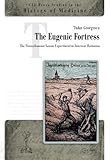The Eugenic Fortress : The Transylvanian Saxon Experiment in Interwar Romania / Tudor Georgescu.
Material type: TextSeries: CEU Press Studies in the History of MedicinePublisher: Budapest ; New York : Central European University Press, [2022]Copyright date: ©2016Description: 1 online resource (290 p.)Content type:
TextSeries: CEU Press Studies in the History of MedicinePublisher: Budapest ; New York : Central European University Press, [2022]Copyright date: ©2016Description: 1 online resource (290 p.)Content type: - 9789633861417
- 363.920949809042
- HQ755.5.R6 G46 2016
- HQ755.5.R6 G46 2016
- online - DeGruyter
| Item type | Current library | Call number | URL | Status | Notes | Barcode | |
|---|---|---|---|---|---|---|---|
 eBook
eBook
|
Biblioteca "Angelicum" Pont. Univ. S.Tommaso d'Aquino Nuvola online | online - DeGruyter (Browse shelf(Opens below)) | Online access | Not for loan (Accesso limitato) | Accesso per gli utenti autorizzati / Access for authorized users | (dgr)9789633861417 |
Frontmatter -- CONTENTS -- LIST OF ILLUSTRATIONS -- ACKNOWLEDGEMENTS -- ABBREVIATIONS -- INTRODUCTION -- CHAPTER I. LOCATING AND DEFINING THE TRANSYLVANIAN SAXON EUGENIC DISCOURSE -- CHAPTER II. ASSESSING THE DYSGENIC CRISIS: KEY CONCEPTS AND THESES IN ALFRED CSALLNER’S DEFINITION OF SAXON DEGENERATION -- CHAPTER III. ALFRED CSALLNER IN SEARCH OF EUGENIC SOLUTIONS AND INSTITUTIONAL MEANS -- CHAPTER IV. FASCIST VISIONS OF A EUGENIC FORTRESS: THE SELF-HELP’S ORIGINS AND RISE TO POWER, 1922–33 -- CHAPTER V. SAXON FASCISM IN POWER, 1933–40 -- CHAPTER VI. 1940 AND EVERYTHING AFTER -- CONCLUSIONS -- BIBLIOGRAPHY -- INDEX OF NAMES -- INDEX OF PLACES
restricted access online access with authorization star
http://purl.org/coar/access_right/c_16ec
The ever growing library on the history of eugenics and fascism focuses largely on nation states, while this monograph asks why an ethnic minority, the Transylvanian Saxons, turned to eugenics as a means of self-empowerment in interwar Romania. The Eugenic Fortress investigates and unpacks the eugenic movement that emerged in the early twentieth century, and focuses on its conceptual and methodological evolution during the interwar period. Further on, the book analyzes the gradual process of politicisation and radicalisation at the hands of a second generation of Saxon eugenicists in conjunction with the rise of an equally indigenous fascist movement. The Saxon case study offers valuable insights into why an ethnic minority would seek to re-entrench itself behind the race-hygienic walls of a 'eugenic fortress', as well as the influence host and home nations had upon its design. Georgescu's work is ground breaking in the sense that the history of this uprooted community is usually handled with sensitivity and serious (and critical) research into Transylvanian Saxon involvement with Nazism has been energetically resisted.
Mode of access: Internet via World Wide Web.
In English.
Description based on online resource; title from PDF title page (publisher's Web site, viewed 30. Aug 2022)


